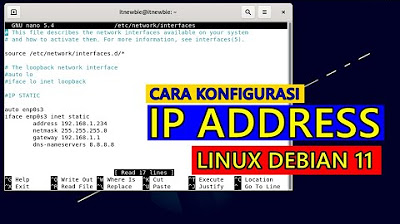How to configure network interface in Redhat Enterprise Linux 7.3 [RHEL-7]
Summary
TLDRIn this video, the host walks viewers through managing network interfaces in Red Hat Enterprise Linux 7 using powerful tools like `nmcli`, `nmtui`, and `nm-connection-editor`. The tutorial covers configuring static IP addresses, DNS, and gateways, as well as managing multiple interfaces through both graphical and command-line methods. It also demonstrates adding and removing network interfaces, making it a comprehensive guide for system administrators and users. With clear instructions and practical examples, this video ensures viewers gain a solid understanding of network configuration in RHEL 7.
Takeaways
- 😀 Network interface management in Red Hat Enterprise Linux 7 is now primarily handled by the NetworkManager tool.
- 😀 The traditional commands for managing network interfaces are deprecated, and the configuration is now mostly done through NetworkManager.
- 😀 There are three primary utilities to manage network interfaces: NM-TUI, nm-connection-editor, and nmcli.
- 😀 NM-TUI (Network Manager Text User Interface) is an easy-to-use text-based interface for configuring network settings, such as IP addresses and DNS servers.
- 😀 The interface naming convention in Red Hat Enterprise Linux 7 has changed to ENS names (e.g., ENS 33), replacing the traditional ethX naming convention.
- 😀 nm-connection-editor provides a user-friendly graphical interface for configuring network settings, but it works only in graphical mode.
- 😀 nmcli (Network Manager Command-Line Interface) is a powerful and flexible command-line tool for network interface management, allowing immediate changes to take effect.
- 😀 Using nmcli, users can view network configurations, activate/deactivate interfaces, and modify IP settings directly from the terminal.
- 😀 To manually assign an IP address using nmcli, the command syntax involves specifying the interface name, IP address, subnet mask, and default gateway.
- 😀 New network interfaces can be added and configured via nmcli, and interfaces can be deleted or modified as needed, all from the command line.
- 😀 DNS settings can be easily modified using nmcli, including specifying DNS addresses and search domains.
Q & A
What is the main topic of the video?
-The video focuses on how to manage network interfaces in Red Hat Enterprise Linux 7, using different tools like NM-TUI, NM Connection Editor, and NMCLI.
Why is the traditional Linux command for managing network interfaces no longer working in RHEL 7?
-In RHEL 7, the network management system has been replaced by the NetworkManager, which introduces a new set of tools for managing network configurations.
What are the three tools introduced for managing network interfaces in RHEL 7?
-The three tools for managing network interfaces in RHEL 7 are: NM-TUI (Network Manager Text User Interface), NM Connection Editor (Graphical User Interface), and NMCLI (Network Manager Command-Line Interface).
How does NM-TUI help users manage network interfaces?
-NM-TUI provides a text-based user interface to configure network interfaces easily without needing to remember complex commands. It offers a step-by-step wizard for tasks like assigning IP addresses manually or using DHCP.
What is the primary benefit of using NM Connection Editor over the command-line tools?
-NM Connection Editor provides a graphical user interface, making it easier for users who are less familiar with command-line operations to configure network settings.
How does NMCLI differ from NM-TUI and NM Connection Editor?
-NMCLI is a command-line interface that provides more detailed control over network configurations and is typically used by advanced users or in environments without a graphical interface. It allows for immediate changes and more precise configurations.
What command would you use to view the network configuration using NMCLI?
-You can use the command `nmcli connection show` to view the network configuration, which lists all interfaces along with their connection details.
How do you modify an IP address using NMCLI?
-To modify an IP address with NMCLI, you can use the command `nmcli connection modify <interface> ipv4.addresses <IP-address>/<prefix>`. This sets a manual IP address for the specified interface.
What command is used to activate or deactivate a network interface with NMCLI?
-To deactivate an interface, use `nmcli connection down <interface>`. To reactivate it, use `nmcli connection up <interface>`.
How do you add a new network interface using NMCLI?
-To add a new network interface, use the command `nmcli connection add con-name <interface-name> type ethernet ifname <interface-name> ipv4.addresses <IP-address>/<prefix>`. This command creates a new connection with the specified IP address.
Outlines

Этот раздел доступен только подписчикам платных тарифов. Пожалуйста, перейдите на платный тариф для доступа.
Перейти на платный тарифMindmap

Этот раздел доступен только подписчикам платных тарифов. Пожалуйста, перейдите на платный тариф для доступа.
Перейти на платный тарифKeywords

Этот раздел доступен только подписчикам платных тарифов. Пожалуйста, перейдите на платный тариф для доступа.
Перейти на платный тарифHighlights

Этот раздел доступен только подписчикам платных тарифов. Пожалуйста, перейдите на платный тариф для доступа.
Перейти на платный тарифTranscripts

Этот раздел доступен только подписчикам платных тарифов. Пожалуйста, перейдите на платный тариф для доступа.
Перейти на платный тариф5.0 / 5 (0 votes)






